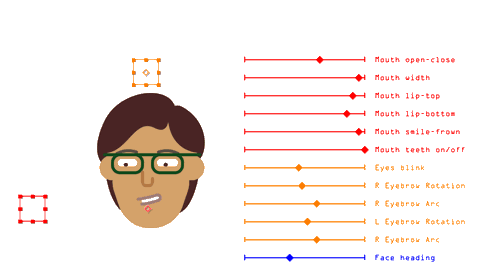Welcome Peppercorn
A most over-engineered birth announcement
Over the past year or so, I’ve fallen in love with 2D character rigging and animation. After several opportunities to rig and animate other folks’ designs, I was itching to see what was possible when I was in the driver’s seat through the entire development process. So, with the arrival of my baby son (nicknamed Peppercorn) imminent, I decided that designing & animating a birth announcement from scratch—secretly, as a surprise to friends, family, and coworkers—sounded like a really smart idea.
The result, after some 120 hours of noodling and experimenting, is a 44-second short film that my wife and I are extremely proud to share. But, much like parenting, raising Welcome Peppercorn to maturity came with a lot of unforeseen pitfalls.
A comedy of [syntax] errors
While mainstays like DuIK and Rubberhose made short work of the broader anatomy in the Jared and Liz rigs, I’d committed early on to pushing myself into more expressive facial animation. Where that’s concerned, my most emphatic advice for character riggers is to invest in Joysticks ‘n Sliders. Because I didn’t, and rigging a faux-3D face without it was a pain in the ass.
Each character in the scene needed blinking eyes, aim-able gazes, and posable mouths, but to really sell the illusion of life in such an intimate scene, I also needed the heads to appear to rotate. For Jared and Liz, that meant matting and foreshortening the beard and hair artwork, as well as dynamically trimming the nose stroke based on the heading of the face. Because I was designing and rigging at the same time—horrible idea, don’t do that—those face-heading rigs became an arcane and delicate mess of DuIK Zero layers, parenting, and patchwork expressions, all piped into an awkward slider control that had to be animated separately from the head’s rotation and position. The results were great, but super tough to unravel for tweaks and fixes. Definitely not my style. For Peppercorn and Hulk (the cat), I reimagined the faux-3D approach from the ground up, including the addition of a simple face-aim null to drive the whole effect, which took a fraction of the time to rig and half as many keyframes to animate. Lesson learned!
Expressions for Jared’s head rig (left) and Hulk’s head rig (right). Our cat may not have a fancy foreshortened beard or much to say with a fully-articulated mouth, but even though Hulk’s rig is functionally simpler, it still looks like I got the hang of face-rigging somewhere between point A and point B.
More than meets the eye
I absolutely love AE’s shape layers. They’re parametric, have deep and dynamic path operation superpowers like merging and trimming (without which we wouldn’t have Rubberhose!), and are the only truly vector-based layers in After Effects other than type. So I figured, why not design all my characters with shape layers?
The first reason not to design your artwork in AE with shape layers: it’s slow. As cool as it is to have nondestructive control over stuff like a rectangle’s roundness, creating each shape from scratch, sizing and positioning it, and managing its complex hierarchy of shape elements and operators is a real slog. Illustrator runs laps around this process, even though you only end up with raw paths to animate with.
The second reason not to design your artwork in AE with shape layers: it’s wicked slow. Those complex hierarchies of shape elements really bog your system down compared to tidy flat artwork, especially if you load up every property with expressions like I did. And considering the ridiculous number of layers an average character rig drags around with it, even the most minor efficiency is worth grabbing when you can.
I also did myself no favors by using Rubberhose for all the things. Eight human limbs, twenty fingers, Peppercorn's rage-thrashing swaddle, and five individual overlapping hoses for Liz's dress all completely murdered any hope of real-time feedback while posing and animating these rigs. If you balked at the 120-hour figure above, it’s safe to say some 30% of that time was spent just waiting for my overwrought rigs to update while I posed them.
The good, the bad, and the baby
While I did set myself up for a lot of nonsense on this journey, I was able to amass some great takeaways from what went right, not just what went sideways:
Design first, rig second, animate third. The design can always adapt later to make the rig work, but it’s silly to start complex face-rigging when you don’t even have all the face parts drawn yet.
Design with design software. Yes, my beloved dynamically-trimmed nose strokes had to be shape layers, but almost everything else in the piece could have been built in Illustrator in way less time.
Rig conservatively. We all want our babies to have every opportunity open to them, but these characters didn’t need half the cool stuff I rigged them for.
Animate purposefully. School of Motion’s Character Animation Bootcamp teaches us to start with posing, then follow with arcs, easing, and offsetting, in that order, and that process is rock solid. For rigs with complex faces, I’d add that fine face work should wait until after offsetting, and start with the broadest movements (such as faux-3D head rotations), follow with eyes (e.g. blinks and saccades), and end with lip syncing (if there’s dialog in the piece). And of course, when offsetting, always lead with the movement’s intention: when the character reaches out her hand, lead with the hand; when she shifts her gaze, lead with the face.
Finally, if a scene feels like it’s missing something, add a cat.
Design, animation, and audio editing by Jared Flynn.



